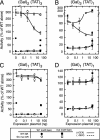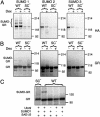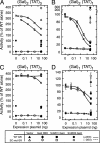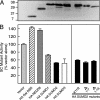Direct and distinguishable inhibitory roles for SUMO isoforms in the control of transcriptional synergy
- PMID: 14663148
- PMCID: PMC307641
- DOI: 10.1073/pnas.2136933100
Direct and distinguishable inhibitory roles for SUMO isoforms in the control of transcriptional synergy
Abstract
Functional interactions between factors bound at multiple sites on DNA often lead to a synergistic or more-than-additive transcriptional response. We previously defined a class of peptide sequences termed synergy control motifs (SC motifs) that function in multiple regulators by selectively inhibiting synergistic activity driven from multiple but not single response elements. By studying the prototypic SC motifs of the glucocorticoid receptor, we show that SC motifs inhibit transcription per se both in cis and in trans, and that a requirement for multiple contacts with DNA renders them selective for compound response elements. Notably, SC motifs are sites for SUMOylation, and the degree of modification correlates strongly with the extent of synergy control. Recruiting SUMO to the promoter either independently or as a fusion to the glucocorticoid receptor is sufficient to recapitulate the in trans and in cis inhibition by SC motifs without apparent changes in subcellular localization. Moreover, we find that the core ubiquitin fold domain of SUMO is sufficient for inhibition and that, independently of their potential for polySUMO chain formation, SUMO-2 and SUMO-3 are more effective inhibitors than SUMO-1.
Figures







Similar articles
-
A synergy control motif within the attenuator domain of CCAAT/enhancer-binding protein alpha inhibits transcriptional synergy through its PIASy-enhanced modification by SUMO-1 or SUMO-3.J Biol Chem. 2003 Mar 14;278(11):9134-41. doi: 10.1074/jbc.M210440200. Epub 2003 Jan 2. J Biol Chem. 2003. PMID: 12511558
-
SUMO-mediated inhibition of glucocorticoid receptor synergistic activity depends on stable assembly at the promoter but not on DAXX.Mol Endocrinol. 2008 Sep;22(9):2061-75. doi: 10.1210/me.2007-0581. Epub 2008 Jun 18. Mol Endocrinol. 2008. PMID: 18562626 Free PMC article.
-
SUMO represses transcriptional activity of the Drosophila SoxNeuro and human Sox3 central nervous system-specific transcription factors.Mol Biol Cell. 2005 Jun;16(6):2660-9. doi: 10.1091/mbc.e04-12-1062. Epub 2005 Mar 23. Mol Biol Cell. 2005. PMID: 15788563 Free PMC article.
-
Sumoylation of internally initiated Sp3 isoforms regulates transcriptional repression via a Trichostatin A-insensitive mechanism.Cell Signal. 2005 Feb;17(2):153-66. doi: 10.1016/j.cellsig.2004.06.007. Cell Signal. 2005. PMID: 15494207
-
Potentiation of glucocorticoid receptor transcriptional activity by sumoylation.Endocrinology. 2002 Sep;143(9):3482-9. doi: 10.1210/en.2002-220135. Endocrinology. 2002. PMID: 12193561
Cited by
-
Controlling a master switch of adipocyte development and insulin sensitivity: covalent modifications of PPARγ.Biochim Biophys Acta. 2012 Jul;1822(7):1090-5. doi: 10.1016/j.bbadis.2012.03.014. Epub 2012 Apr 4. Biochim Biophys Acta. 2012. PMID: 22504298 Free PMC article. Review.
-
PIASγ enhanced SUMO-2 modification of Nurr1 activation-function-1 domain limits Nurr1 transcriptional synergy.PLoS One. 2013;8(1):e55035. doi: 10.1371/journal.pone.0055035. Epub 2013 Jan 24. PLoS One. 2013. PMID: 23358114 Free PMC article.
-
Protein kinases mediate ligand-independent derepression of sumoylated progesterone receptors in breast cancer cells.Proc Natl Acad Sci U S A. 2009 Aug 25;106(34):14287-92. doi: 10.1073/pnas.0905118106. Epub 2009 Aug 17. Proc Natl Acad Sci U S A. 2009. PMID: 19706513 Free PMC article.
-
A Flp-SUMO hybrid recombinase reveals multi-layered copy number control of a selfish DNA element through post-translational modification.PLoS Genet. 2019 Jun 26;15(6):e1008193. doi: 10.1371/journal.pgen.1008193. eCollection 2019 Jun. PLoS Genet. 2019. PMID: 31242181 Free PMC article.
-
Progesterone receptors act as sensors for mitogenic protein kinases in breast cancer models.Endocr Relat Cancer. 2009 Jun;16(2):351-61. doi: 10.1677/ERC-08-0281. Epub 2009 Apr 8. Endocr Relat Cancer. 2009. PMID: 19357196 Free PMC article. Review.
References
-
- Yamamoto, K. R., Darimont, B. D., Wagner, R. L. & Iniguez-Lluhi, J. A. (1998) Cold Spring Harbor Symp. Quant. Biol. 63, 587-598. - PubMed
-
- Carey, M. (1998) Cell 92, 5-8. - PubMed
-
- Subramanian, L., Benson, M. D. & Iñiguez-Lluhí, J. A. (2003) J. Biol. Chem. 278, 9134-9141. - PubMed
-
- Hiort, O., Holterhus, P. M., Horter, T., Schulze, W., Kremke, B., Bals-Pratsch, M., Sinnecker, G. H. & Kruse, K. (2000) J. Clin. Endocrinol. Metab. 85, 2810-2815. - PubMed
Publication types
MeSH terms
Substances
Grants and funding
LinkOut - more resources
Full Text Sources
Molecular Biology Databases

